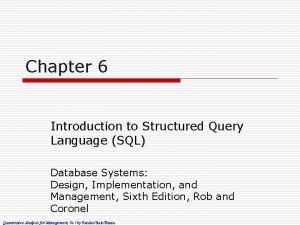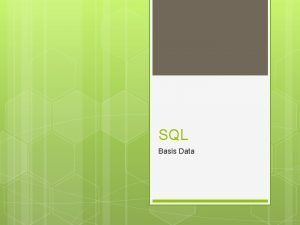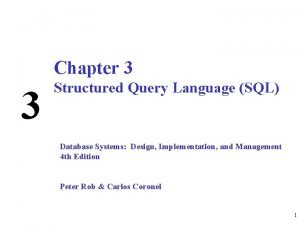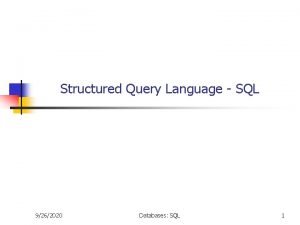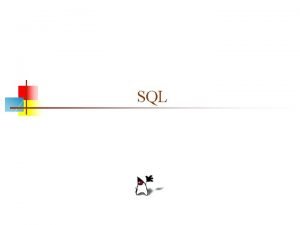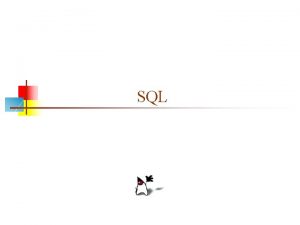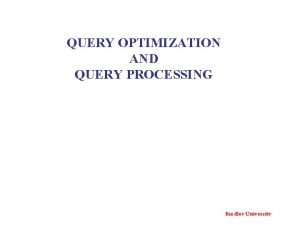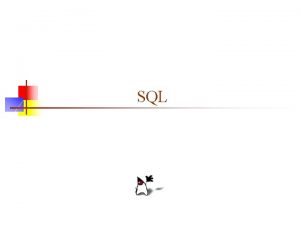SQL Structured Query Language 1 Structured Query Language












- Slides: 12

SQL Structured Query Language 1

Structured Query Language • Data Definition Language (DDL) is used to manage table and define data structure i. e. CREATE, ALTER, DROP • Data Control Language (DCL) is used to control user’s privilege on accessing data i. e. GRANT, REVOKE • Data Manipulation Language (DML) is used to manage data record i. e. ADD, UPDATE, and DELETE. – This may include SELECT but it may be consider as a member of Data Query Language (DQL) 2

Browsing Databases • Some useful commands to begin with – – – show databases; use <database_name>; show tables; desc <table_name>; create database <database_name>; • Create a new database CREATE DATABASE Bang. Na; 3

Create a Table CREATE TABLE <table_name> ( column_name 1 <col_type> …. . , . . . column_name 2 <col_type> …. . , . . . ……………. . ) CREATE TABLE std_phone ( STD_ID INT NOT NULL AUTO_INCREMENT PRIMARY KEY, FNAME VARCHAR (64) NOT NULL , LNAME VARCHAR(64 ) NOT NULL , PHONE VARCHAR(12) NOT NULL ) 4

Create a User • It is a good idea to create a username to manage tables in new created database • Proper privileges can be granted to a particular user so that only a user who has right access can manage the table GRANT <previledge> [(col 1, col 2, … col. N)] ON database. [table] TO user@host IDENTIFIED BY 'passwd'; GRANT select ON webtech. student_profile TO tct IDENTIFIED BY ‘tct'; 5

SELECT Statements • Select all records (rows) from a table SELECT * FROM <table_name>; SELECT * FROM std_phone; • Select some columns of all records from a table SELECT col 1, col 2, …. coln FROM <table_name>; SELECT std_id, fname, lname FROM std_phone; 6

SELECT Statements (cont. ) • Select some records from a table SELECT * FROM <table_name> WHERE <condition>; • WHERE clause could be any boolean expression SELECT * FROM std_phone WHERE std_id < 20; SELECT * FROM std_phone WHERE std_id < 20 AND fname like ‘sor%’; 7

INSERT INTO • Insert a record into a table INSERT INTO table (col 1, col 2, col 3) VALUES(val 1, val 2, val 3; ( INSERT INTO std_phone (fname, lname, phone) VALUES(“Khaosai”, “Galaxy”, “ 088 -123 -4567”); • Insert record(s) from a table right into another table INSERT INTO std_phone (fname, lname, phone) select fname, lname, phone from std_profiles where academic_year = ‘ 2552’; 8

Edit a Record • Modify a record UPDATE <table> SET field 1=’val 1’, field 2=’val 2’, field 3=’val 3’ WHERE <condition>; • Modify Khaosai’s phone number UPDATE std_phone SET phone=‘ 089 -1234’ WHERE fname = ‘Khaosai’ AND lname = ‘Galaxy’; 9

Delete Record(s) • Delete selected record(s) DELETE FROM <table> WHERE <condition>; • Delete Khaosai’s record from the table DELETE FROM std_phone WHERE fname = ‘Khaosai’; – This will delete all records with firstname ‘Khaosai’ DELETE FROM std_phone WHERE lname = ‘Galaxy’; – This will delete all records with lastname ‘Galaxy’ 10

Delete Record(s) • Do a better job with AND DELETE FROM std_phone WHERE fname = ‘Khaosai’ AND lname = ‘Galaxy’; – Anyway, this would be a better choice by using primary key to locate the target record to be deleted. DELETE FROM std_phone WHERE std_id = 20; • Note: avoid this; DELETE FROM std_phone; – it will delete all records in the tatble 11

12
 Language
Language Introduction to structured query language (sql)
Introduction to structured query language (sql) Sql merupakan singkatan dari
Sql merupakan singkatan dari A structured query language – sql operators are
A structured query language – sql operators are Select * from tab
Select * from tab Structured query language (sql) is an example of a(n)
Structured query language (sql) is an example of a(n) Structured query language (sql) is an example of a(n)
Structured query language (sql) is an example of a(n) Sql n''
Sql n'' My structured query language
My structured query language Convert natural language to sql query
Convert natural language to sql query Iterative query vs recursive query
Iterative query vs recursive query Query tree and query graph
Query tree and query graph Query tree and query graph
Query tree and query graph
